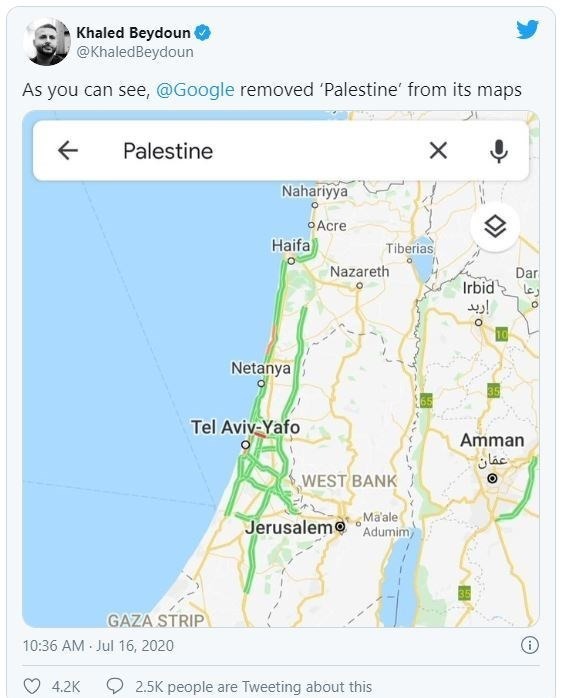The spirit of the Palestinian resistance knows no rest or break, and with the outrage caused by the accused removal of the country from the maps, the spirit is thus heightened and enlarged.
Google and Apple have been accused of removing Palestine from their online maps, due to a post that circulated all over social media outlets concerning the disappearance of Palestine. The post went viral and Arab social media users have been flocked to all platforms in order to voice their outrage and concerns regarding the removal.

What Does This Mean?
The prompted outrage at the removal of Palestine stemmed from the appearance of an outline for the Gaza Strip and West Bank territories, but the blatant disappearance of the labels for Palestine. Hence, when searching for Palestine on the online maps, there will be no results for tangible and apparent labels, claimed the Independent on an article concerning the removal of Palestine.

Thus, the disappearance of Palestine triggered an online protest in light of the Palestinian resistance towards injustice stemming from Israel, and all over social media, the Palestinian fight has been in action.
The social media protests spread across all platforms and outlets were enabled and done through users sharing their outrage using the hashtag #PalestineIsHere, highlighting how the removal of Palestine from the maps does not mean that the country ceases to exist.
But while the resistance and the fight are still very important and valid — there appeared to be discrepancies and misinformation regarding the removal of the country from the online maps.
Going Beyond Social Media Reactions
As stated by a Google representative, “there has never been a ‘Palestine’ label on Google Maps, however, we discovered a bug that removed the labels for ‘West Bank’ and ‘Gaza Strip’. We’re working quickly to bring these labels back to the area,” The Guardian explained in an article.
The Guardian also claimed that this was not Google’s first incident at disrupting geographical disputes “this is not the first time Google has got into hot water over disputed territories – and it’s likely not to be the last. A 2014 project called Disputed Territories documented how Google Maps attempts to stay out of geographical disputes and issues of national identity,” as stated.
In the case of Palestine, the dispute is heightened because of the long-fight against Israel and injustice. The tech-firm is now being accused of supporting Israel’s occupation in spite of the statement claiming that there is an influx of “false information” on social media platforms. Palestine is recognized by the United Nations and 136 of its members as an independent state, but not in the US where Apple and Google are headquartered.
Israeli prime minister Benjamin Netanyahu promised to begin annexing parts of the occupied West Bank last month by prompting more than 1,000 parliamentarians from across Europe to sign a joint letter of protest.
But the Palestinian fight does not stop there and does not begin there, it begins and ends when there the rightful ownership of their lands is brought back to them.

The digitized world we live in has paved the way for underscoring and highlighting many political and social issues. Digital maps now have the capacity and power of asserting and underscoring national identities as well as reinforcing claims of ownership, as stated in an article by the European Journal of Geography.
For the Palestinians, this is a cathartic move. It reinforces the reason for their resistance, for the injustices they have suffered and continue to, and for asserting their right to ownership and historical belonging to the land.




























